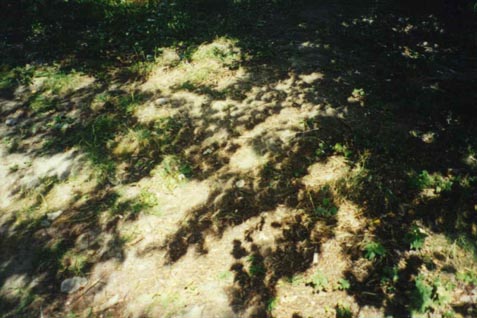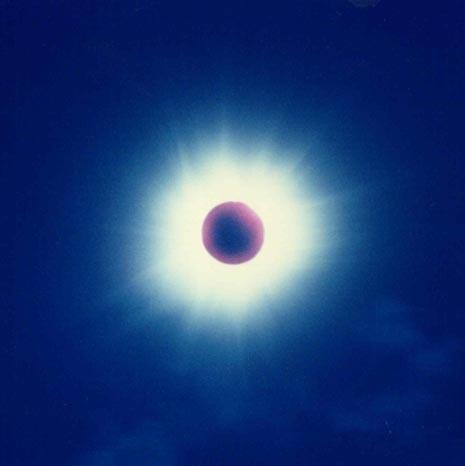
The 11 July 1991 eclipse was the first in my experience to garner major publicity where we live in Southern California. We actually went to Kauai in June. We had been to the Big Island of Hawaii in 1987 and were more interested in visiting a new island than seeing the eclipse. This illustrates the importance of tracking eclipses a decade or so away. In retrospect we could have easily reversed the destinations of the 1987 and 1991 trips. The 1991 eclipse was only 70% in Los Angeles, but the grating of the parking garage at my work created thousands of small crescent images on the nearby walls.
The annular eclipse of 4 January 1992 was well publicized, as the path of annularity at sunset extended from north of Los Angeles to Ensenada in Mexico. The Los Angeles basin was completely overcast, so we drove south to Laguna Beach in the midafternoon. As the clouds from the north were moving our way, we moved south again to a hill above San Clemente by 3:30PM. We had a clear view until about 15 minutes before sunset, when the horizon clouds caught up with us. Naturally, the next day's paper had a perfect annular sunset picture from San Diego on the front page.
A few days earlier, we attended a Griffith Observatory presentation on eclipses and picked up their monthly bulletin. The bulletin listed the remaining solar eclipses of the 1990's. I mentally filed away 11 August 1999, as all of the others seemed impractical, particularly considering our children were ages 6 and 2 in January 1992.
Our 14-year old Adam sings in Los Angeles Childrenís Chorus Concert Choir, which tours internationally in odd-numbered years. As they toured Australia in 1997, we expected a European tour in 1999. Last fall it was announced that their 10-day tour in Eastern Europe would end in Prague 10 August. We planned to spend the next two weeks in Austria and southern Germany, starting in Vienna. After reading Fred Espenakís web site, I decided to remain flexible among Germany, Austria and Hungary for the eclipse, but Lake Balaton was the clear favorite based upon weather history.
We checked web weather predictions in our Prague hotel: they were optimistic on 6 August but gloomy on 9 August. We stuck to our original plan for Adam and my wife Becky to take an overnight train from Prague to Budapest. Meanwhile, I would drive our rental car to Budapest on 10 August with our 10-year old Andrew.
The afternoon drive on 10 August was gray and drizzly in the Czech Republic, and it poured rain through our hour in Slovakia. Just south of Bratislava, there was a partial clearing with an impressive rainbow. However, when we reached Budapest, the hotel concierge said that they expected the storm to reach Budapest, and that if it was raining in the morning we should go west toward Austria and try to get behind the storm.
When I awoke on August 11 in Budapest, it was 100% overcast. Fortunately, the weather cleared with just a few light clouds as we drove south from the city. When we reached Lake Balaton, we chose Siofok on the south side of the lake, in case poor weather approached and we needed to move southeast. We did not know that it had rained at Balaton during the night and that the storm had already passed.
We arrived at the Siofok lakefront at 10AM. The lakefront is about a 10-foot wide levee with a stone pathway in the middle. Trees were planted for the next 20-30 feet, and the levee is so narrow that you need to walk into the lake to see the sun over the trees in many places. As the lakefront was also very busy, we decided to set up our camera in a grass parking area on the other side of the trees. We were next to Rolf, an amateur astronomer from Pisa, Italy, who had an impressive solar telescope.
In the hour before totality, we took pictures every 10 minutes of the partial eclipse. There were a few clouds, but most were so thin that you could still see the sun through them. Only once did we need to wait for a cloud to pass while taking the partial pictures. We expected to see crescent images from the trees, but they did not appear until 15 minutes before totality. The images were fewer in number but much larger in size than in 1991.
 |
After our last partial picture, we walked to the lakefront, where we hoped to see the wall of darkness come over the lake. The sky was noticeably darker to the NW where totality was approaching than the NE view, which looked like a normal day by comparison. The low hills on the opposite side of Lake Balaton and the thin clouds prevented us from seeing a discrete shadow line approaching us. I would instead describe it as a sunset in fast-forward, suddenly turning dark at the end. I then instinctively looked up and saw a diamond ring flash, followed by totality.
From Budapest, Dad drove us all to Lake Balaton to watch the eclipse. We met an Italian guy there named Rolf. He had a really big telescope and a lot of other equipment for the eclipse. The camera he had attached to the telescope to take pictures. He also taped his video camera to the telescope to videotape the eclipse. He taped welderís glass to the video camera and to his binoculars to protect them from the sun. We set up our stuff near him in the flat parking area. We had only the camera on a tripod for pictures. After first contact (during the first partial phase) we took a picture every ten minutes. At the last part of the partial phase, we could see the crescent shape in the shadows of trees.
We went down to the lake to await second contact. There appeared progressively a sunset color over the hills on the far side of the lake and then it went dark very suddenly. We looked up at the moon then and for a second we could see the diamond ring. Then it disappeared and the corona and red prominences were visible. A distant sunset glow was visible in all directions across the lake. Dad and I ran back to the camera and worked through the settings to take the pictures. About ten seconds after the last picture, the moon passed third contact and we were out of totality.
During the 2:20 of totality, I saw only one star (which was probably Venus) in the sky. It was about as dark as dark twilight or a full moon. The birds stopped singing and there were a lot of cheers from people. I heard a few corks pop off of champagne, but most of all people were yelling and cheering.
In the hour before second contact I wore very dark polarized prescription sunglasses. I thought they would help my night vision during the short period of totality. This proved to be correct as I could easily read the small print speed setting on our manual camera. What I forgot was my dismal nearsightedness without corrective lenses. I had left my regular glasses in the car, and when I removed my sunglasses the eclipsed sun was a blur. Nonetheless, the view of totality was still impressive with polarized sunglasses. The corona looked like white lace, symmetric and perhaps one sun-width wide. Most impressive were the laser red prominences, at least 3 large ones, including the detached one at 4 o'clock. Needless to say, I missed the outer corona and any visible stars.
Since the view through the sunglasses was a surprise (besides being my first time!), I probably stared for quite a while. When finally I told Adam to go back to our manual camera and tripod, he had already gone. My younger son Andrew said I actually aimed the automatic camera around my neck at the sun before realizing that I needed to get moving.
Adam sighted the camera while I changed exposures. Soon after we finished, the sun emerged and we did not have time to reset the exposures for a diamond ring picture. I had hoped to capture the prominences on the short exposures, but they did not show up. Our long exposures of totality show a symmetric and spiky corona with some dark reddish earthshine on the moon.
 |
When it was all over, Andrew and I took a relaxing swim in Lake Balaton. It is shallow quite a distance from shore and thus very warm, at least 75F, in the summer.
Fred Espenak's eclipse page is a valuable resource. Particularly helpful were his weather prospects pages. During the ensuing 2 weeks in Austria and Germany, it became evident that our chances of seeing the eclipse in either country on 11 August would have been well under 50%.
All the comments about partial eclipses being no big deal compared to totality are definitely true. Other than direct viewing through eclipse glasses, it is hard to see any effects until about 15 minutes before totality. I can see how people in ancient times might have been taken completely by surprise, and thus freaked out. 2nd and 3rd contact are a sensory overload. Thereís not enough time to see everything thatís going on.
The sunglasses were a good idea. Just donít forget clear prescription glasses if you need them.
Ration your totality camera time if youíre not completely automated and itís a relatively short eclipse. I probably spent less than half of totality "just looking".
WebMaster: MrEclipse
Last revised: 2008 Jan 28